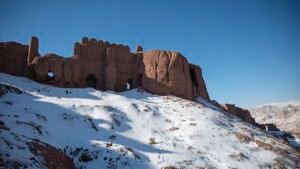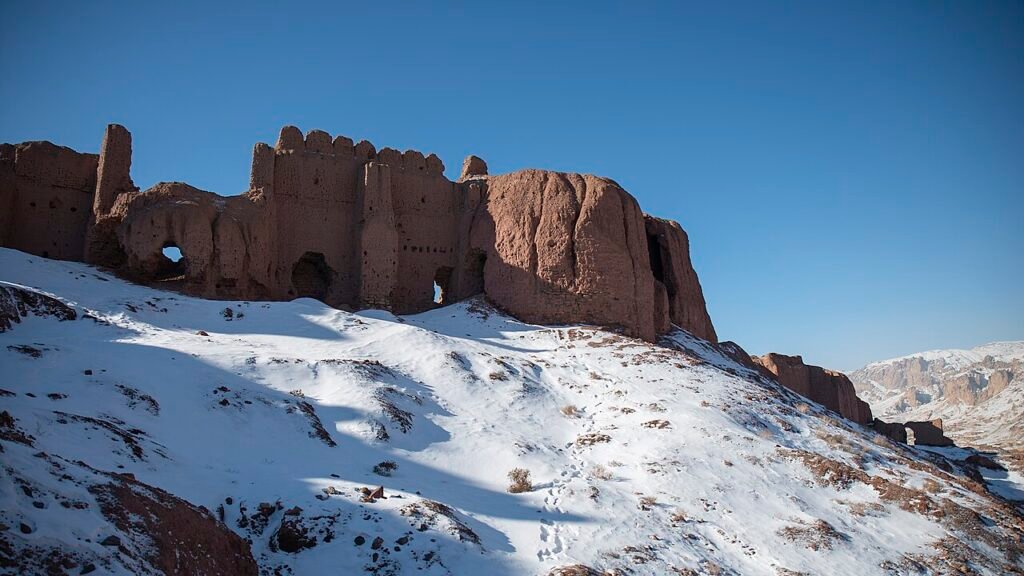Without a doubt! Here is a list of 17 of Afghanistan’s most popular tourist destinations, along with a description of each one:
Bamiyan Valley
The valley, situated in the Hindu Kush mountain range, gained renown for its enormous Buddha sculptures carved into the cliffs. Unfortunately, the Taliban destroyed these statues in 2001. Despite its loss, the valley retains tremendous historical and cultural value. It features old cave homes, monasteries, and remnants of the Silk Road, offering tourists insight into Afghanistan’s rich history.
The city of Kabul
which serves as the capital and biggest city of Afghanistan, is a bustling metropolis that is brimming with activity. In spite of the wounds left by conflict, Kabul has managed to preserve its historical appeal. This is obvious in places such as the Kabul Museum, which is home to a vast collection of Afghan artefacts that span centuries. Visitors have the opportunity to visit the busy marketplaces, take a walk along the Kabul River, and appreciate sites such as the Kabul Citadel, which serves as a tribute to the city’s continuing endurance.
Herat
which is located in the western part of Afghanistan, is a city that is well-known for its extensive cultural history as well as its breathtaking architecture. The city was an important hub along the old Silk Road, which allowed for a thriving flow of products and ideas between the many countries along the route. The Herat Citadel, listed as a UNESCO World Heritage Site, and the Friday Mosque, renowned for its beautiful tilework and minarets, attract attention as two of the most notable attractions.The bazaars of Herat, which are brimming with Afghan handicrafts and spices, provide an immersing glimpse into the everyday lives of the Afghan people.
Mazar-e-Sharif
Also referred to as the “Tomb of the Exalted,” Mazar-e-Sharif is a significant cultural and religious centre located in the northern region of Afghanistan. One of the most respected pilgrimage sites for Muslims all over the globe is the Shrine of Hazrat Ali, which is located in this city. During holidays like Nowruz, visitors have the opportunity to observe the lively traditions of Sufism. These festivals feature colorful processions and music. Another architectural masterpiece that should not be overlooked is the Blue Mosque, adorned with tiles of blue color.
Panjshir Valley
The Panjshir Valley is a scenic sanctuary recognized for its pure natural beauty and rough terrain. It is located in the Hindu Kush mountains and tucked away in a remote location. It is a popular destination for those who like trekking because of the twisting routes that pass through verdant valleys, rivers that are crystal clear, and mountains that are tall.The valley offers an invigorating respite from the commotion of city life, known for its peaceful environment and genuine friendliness.
Band-e Amir National Park
Band-e Amir, Afghanistan’s first national park, is a place that captivates tourists with its spectacular beauty. Natural dams made of travertine mineral deposits have resulted in the formation of a number of breathtaking blue lakes that are spread throughout the park. Waterfalls that plunge down sharp limestone cliffs have formed a strange oasis in the middle of the dry desert. Hiking along the paths, going boating on the lakes, or just taking in the peaceful surroundings are all activities that visitors may enjoy.
The Khyber
Conquerors, merchants, and travelers have traversed the Khyber route for millennia. Steeped in history and folklore, it holds strategic importance as a mountain pass. By establishing a connection between Afghanistan and Pakistan, it has been essential in determining the course of events in the area. Visitors can explore the challenging landscape, dotted with historic forts and watchtowers that offer breathtaking views of the surrounding mountains and valleys.
Tora Bora
In the early 2000s, this island in the White Mountains of eastern Afghanistan captured the attention of the world community when it served as a bastion of the Taliban and subsequently became a battlefield in the war on terror. Guerrilla combatants took advantage of the territory’s intricate cave networks, earning the region a well-deserved reputation. Despite its troubled history, tourists are drawn to Tora Bora for its rocky beauty and historical importance, with a keen interest in history and adventure.
Kandahar
kandahar is one of the oldest towns in Afghanistan and a cultural melting pot of Pashtun traditions. It is also a city that is steeped in history and mythology. The city is home to a diverse collection of architectural landmarks, such as the historic Citadel of Alexander and the tomb of Ahmad Shah Durrani, the man who first established the modern nation of Afghanistan. Visitors may immerse themselves in the vivid tapestry of Kandahari life while exploring busy bazaars, sampling exquisite Afghan food, and experiencing the culture of the region.
The city of Jalalabad
, which is located in the picturesque province of Nangarhar, is well-known for its verdant landscapes, rich valleys, and historical sites. There are a variety of cultural attractions available in the city, such as the Mausoleum of King Amanullah Khan and the ancient ruins of Hadda. Adventurers who like being outside may go on trips to the Tora Bora mountains, which are located close, or they can rest by the Kabul River, which is a beautiful river.
Gardens of Babur
The Gardens of Babur are a quiet oasis in the middle of the urban tumult. They are perched on the slopes of Sher Darwaza Hill, which is located in Kabul. The first Mughal emperor, Babur, constructed these terraced gardens in the 16th century. They are ornamented with colourful flowers, fruit trees, and water channels that run in a continuous pattern. Visitors get the opportunity to stroll along the walkways, take in the exquisite marble pavilions, and take in the breathtaking views of Kabul city below.
Paghman Gardens
Paghman Gardens, which are located only a short drive away from Kabul, provide a tranquil escape from the commotion and activity of daily life. The beautiful gardens boast fountains, cypress trees, and rose bushes, set against the backdrop of snow-capped mountains. Guests can picnic on the banks of the Paghman River, stroll along shaded paths, or enjoy traditional Afghan cuisine in the on-site restaurants.
Takht-e Rostam
Tucked away in the craggy highlands of Samangan Province, the ancient archaeological site of Takht-e Rostam exudes mystery. The location boasts numerous rock-cut chambers, stupas, and monastic cells carved into the cliffs. These structures date back to the historical period of Buddhism. The elaborate carvings and inscriptions that give insights into Afghanistan’s rich cultural history and religious traditions are available for visitors to examine.
Shahr-e-Zohak
Located on a rocky outcrop overlooking the Bamiyan Valley, the ancient fortification of Shahr-e-Zohak, sometimes referred to as the Red City, is a place of great significance. Archaeologists believe that people have inhabited the area since the third century BCE, providing a fascinating glimpse into Afghanistan’s history before the arrival of Islam. As they make their way through the labyrinth of collapsing walls and towers, tourists might have the opportunity to imagine the city’s previous greatness while taking in the breathtaking natural environment.
Shahr-e Gholghola
which literally translates to “City of Screams,” is an archaeological site close to Bamiyan that serves as a reminder of the atrocities committed during Genghis Khan’s Mongol invasion in the 13th century. The old city, once a vibrant center of culture and commerce, now lies scattered over a barren terrain devoid of any vegetation.. As they wander around the ruins of collapsing walls and defences, tourists have the opportunity to contemplate the ephemeral nature of empires while taking in the breathtaking natural beauty of the Afghan countryside.
Babur’s Tomb
The 16th-century mausoleum, dedicated to Emperor Babur, the founder of the Mughal Empire, stands magnificently on a slope overlooking Kabul. Mughal architecture adorns the monument with its beautiful marble carvings and geometric patterns on its surface. It is a tranquil retreat that serves as a somber reminder of Afghanistan’s rich cultural heritage. Cypress trees and lush gardens surround it on all sides.



